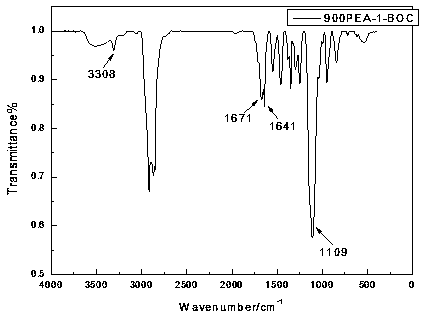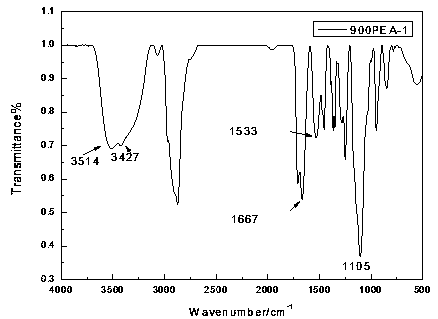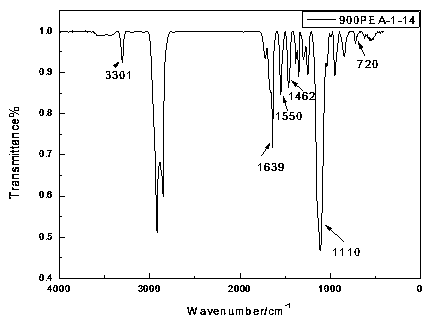Amphiphilic luminescent molecule with AIE (aggregation-induced emission) characteristic and preparation method
An aggregation-induced luminescence and amphiphilic technology, applied in the direction of luminescent materials, chemical instruments and methods, etc., to achieve the effect of broadening the application range, overcoming hydrophobicity and high toxicity, and simple process
- Summary
- Abstract
- Description
- Claims
- Application Information
AI Technical Summary
Problems solved by technology
Method used
Image
Examples
Embodiment 1
[0028] The preparation method of amphiphilic light-emitting molecules with aggregation-induced light-emitting properties of the present invention is carried out sequentially according to the following steps:
[0029] a. Add polyetheramine Jeffamine ED900 and BOC-glycine into a round bottom flask in turn and dissolve it with dichloromethane. Add DCC (dicyclohexylcarbodiimide) at an ice bath temperature of 0°C. Stir magnetically for 1 hour to rise to room temperature, TLC Monitor the reaction process until the reaction is complete, and filter to obtain a colorless filtrate, which is the first intermediate product (900PEA-1-BOC); the molar ratio of Jeffamine ED900, BOC-glycine, and DCC is 1:3:3;
[0030] The infrared spectrum of the first intermediate product (900PEA-1-BOC) is as follows figure 1 shown.
[0031] b. Combine the first intermediate product (900PEA-1-BOC) with CF 3 COOH is mixed according to the mass ratio of 1:2, stirred at room temperature, and added with CF 3 E...
Embodiment 2
[0037] Add 900PEA-1 and palmitic acid prepared in the same way as in Example 1(a)(b) into a round bottom flask, add dichloromethane to dissolve, add DCC, stir magnetically until the reaction is complete (TLC monitors the reaction process), filter , evaporated to dryness, washed with petroleum ether several times, evaporated to dryness, and dried in a drying oven at 80°C for 5 hours to obtain the target product, namely 900PEA-1-16, the second intermediate product (900PEA-1), palmitic acid, The molar ratio of DCC is 1:2.5:2.5.
[0038] The infrared spectrum of the amphiphilic luminescent molecule (900PEA-1-16) with aggregation-induced luminescent properties is as follows Figure 5 shown.
Embodiment 3
[0040] Add 900PEA-1 and stearic acid prepared in the same way as in Example 1 (a) (b) into a round-bottomed flask, add dichloromethane to dissolve, add DCC, and magnetically stir until the reaction is complete (TLC monitors the reaction process), Filtrate, evaporate the solvent to dryness, wash with petroleum ether several times, evaporate the solvent to dryness, and dry in a drying oven at 80°C for 5 hours to obtain the target product, namely 900PEA-1-18, the second intermediate product (900PEA-1), stearin The molar ratio of acid to DCC is 1:2.5:2.5.
[0041] The infrared spectrum of the amphiphilic luminescent molecule (900PEA-1-18) with aggregation-induced luminescent properties is shown in Image 6 shown.
PUM
 Login to View More
Login to View More Abstract
Description
Claims
Application Information
 Login to View More
Login to View More - R&D
- Intellectual Property
- Life Sciences
- Materials
- Tech Scout
- Unparalleled Data Quality
- Higher Quality Content
- 60% Fewer Hallucinations
Browse by: Latest US Patents, China's latest patents, Technical Efficacy Thesaurus, Application Domain, Technology Topic, Popular Technical Reports.
© 2025 PatSnap. All rights reserved.Legal|Privacy policy|Modern Slavery Act Transparency Statement|Sitemap|About US| Contact US: help@patsnap.com



